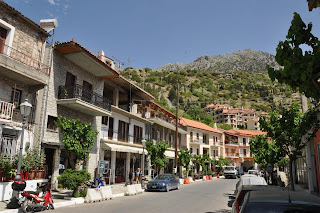We stayed at the Athens Gate Hotel, a lovely hotel in an excellent location near the Plaka area. It has a fantastic view of the Acropolis from its rooftop restaurant - see views below.
The Plaka is the historic centre of Athens and remains the oldest continuously inhabited area of the city. It is full of shops, tavernas and tourists. See a general view and a taverna we ate at below.
One night we dined on local dishes of moussaka and stuffed tomatoes at Ydria, a local restaurant in the Plaka - see below.
In the Plaka is a little 12th century church called Panagia Gorgoepikoos ("The Madonna Who Swiftly Hears"). Often called the Little Cathedral. See pic below.
We did a one day bus trip to Delphi, passing through the little village of Arachovia in the mountains. The bus stops in front of a souvenir shop from which very aggressive salespeople spring on the tourists.
In ancient times, Delphi was a major shrine of the god Apollo, and famous for the ambiguous utterances of the oracle of Delphi (hence the expression "a Delphic statement"). It was once considered to be the centre of the world, and the rock in the following picture was known as the Omphalos (The Navel of the Earth).
Delphi was the site of the treasuries of many of the Greek city states, due to the security of being in a sacred site. The restored Athenian Treasury building is in the pic below.
The Temple of Apollo was a major building on the site - see pics below. It is mostly ruined now, but must have been impressive in its time. A huge statue of Apollo stood nearby, of which only the base remains to remind of its size.
Delphi has a major museum devoted to items recovered from excavations. The pic below shows a frieze called The Battle of the Olympian Gods against the Giants.
We visited the Acropolis to see the ruined buildings (some of which are gradually being restored - the manner of this being a subject of some controversy). The pics below show the Parthenon and the Porch of the Caryatids.
Monastiraki is another historic area of Athens and takes its name from a little sunken monastry in the area. It has a flea market which we visited, selling everything from junk to jewellery. See pic of flea market and of local snack, "koulouri" (Greek bagel).
There are ancient ruins in the area (like most others). The pic below shows the Tower of the Winds, an unusual octagonal structure which was built as a water clock and weather vane in the 1st century BC.
Next update will cover the Greek Islands.
Tuesday, May 18, 2010
Subscribe to:
Post Comments (Atom)

















No comments:
Post a Comment